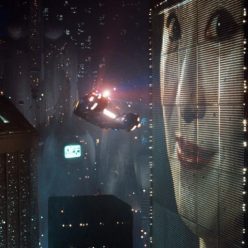https://www.youtube.com/watch?v=cewBN6iWDns
Someone who is a big inspiration for me is Buster Keaton, a pioneer of visual storytelling. Keaton was mainly active in the early twentieth century where films were silent, black and white features and stories were told through subtitle cards and orchestras. At the turn of the century an average feature length film had 240 subtitle cards throughout the movie, whilst the most Buster Keaton ever included was just over fifty. This is an example simply to illustrate how Keaton told a tale in a completely original and unique way; the influences of which can still be seen today – be it cinematically in Wes Anderson’s directing, physically in Bill Murray’s performances or even Christopher Nolan’s large, animatronic set pieces.
Keaton was ground breaking at the time for telling a story physically; through expression, gesture and pantomime. It was action that told the audience what a character was feeling or saying; very much show and not tell. Personally this is something I very much love and think is lacking in cinema today – faith in the audience. Keaton doesn’t treat his audience as if they are stupid, he allows them room to understand and interpret whilst a lot of films currently spoon feed their audiences as if they couldn’t work it out for themselves; rife with exposition and generic dialogue.
One of the main reasons that Keaton’s specific style was so successful and has held the test of time is that he followed a set of rules in the world he created; a flat world. Where what we and the camera see is all that the character can see also, the movement of the camera or other objects in the scene that reveal something new to us are at the same time being revealed to Keaton. He also understood people and what draws their attention, to where and for how long – this is why all the movement of the characters in the film is towards or away from the camera, horizontal or vertical. He told his narrative with simple directions and geography so that as the characters move so does the story in that direction; it is also where he found his physical humour and framing, with geometric shapes and action. These principles that Keaton set in his productions are what I wish to be inspired by and follow in my own making.
HB
bibliography
After Hours at Rick’s. (2014). Wes Anderson’s Grand Budapest Hotel; confecting a modern Buster Keaton comedy. [online] Available at: https://afterhourswithersi.wordpress.com/2014/03/25/wes-andersons-grand-budapest-hotel-confecting-a-modern-buster-keaton-comedy/.
Barnard, L. (2014). Wes Anderson shares secrets about making the Grand Budapest Hotel | Toronto Star. [online] thestar.com. Available at: https://www.thestar.com/entertainment/movies/2014/03/13/wes_anderson_shares_secrets_about_making_the_grand_budapest_hotel.html.
Bordwell, D. (2007). Observations on film art » Funny framings » Print. [online] Davidbordwell.net. Available at: http://www.davidbordwell.net/blog/2007/04/30/funny-framings/print/.
Hamid, R. (2014). The General. [online] Senses of Cinema. Available at: http://sensesofcinema.com/2014/cteq/the-general/.
Hauser, F. and Reich, R. (2003). Notes on directing. New York: Walker & Co.
Keaton, B. and Sweeney, K. (2007). Buster Keaton. Jackson: University Press of Mississippi.
Knopf, R. (1999). The theater and cinema of Buster Keaton. Princeton, NJ: Princeton University Press.
Kunze, P. (2014). The films of Wes Anderson. Palgrave Macmillan.
LYNSKEY, D. (2014). Film By Film: Wes Anderson On Wes Anderson. [online] Empire. Available at: https://www.empireonline.com/movies/features/wes-anderson/ [Accessed 1 Jan. 2018].
Morefield, K. (2015). Faith and spirituality in masters of world cinema. Newcastle upon Tyne: Cambridge Scholars Publishing.
Mufson, B. (2018). Why Buster Keaton’s the OG of Physical Comedy. [online] Creators. Available at: https://creators.vice.com/en_uk/article/vvyx9j/why-buster-keatons-the-og-of-physical-comedy.
Prikryl, J. (2011). The Genius of Buster. [online] The New York Review of Books. Available at: http://www.nybooks.com/articles/2011/06/09/genius-buster-keaton/.
Puschak, E. (2016). Scott Pilgrim: Make Your Transitions Count.
Available at: https://www.youtube.com/watch?v=pij5lihbC6k.
Runquist, K. (2017). Edgar Wright: How to Make a Protagonist | Video Essay. [online] YouTube. Available at: https://www.youtube.com/watch?v=p6nFIogiMRg.
Terkel, S. and Keaton, B. (1960). Buster Keaton talks with Studs Terkel ; 1960/09/05.
Trahair, L. (2004). The Narrative-Machine: Buster Keaton’s Cinematic Comedy, Deleuze’s Recursion Function and the Operational Aesthetic. [online] Senses of Cinema. Available at: http://sensesofcinema.com/2004/comedy-and-perception/keaton_deleuze/.
YouTube. (2018). Casino Royale shot – Whip Pan. [online] Available at: https://www.youtube.com/watch?v=6qjCwb9DoaI.
YouTube. (2018). Hızlı Pan (Whip Pan) – Bruce Lee. [online] Available at: https://www.youtube.com/watch?v=KTTAbdUL1LQ.
Zhou, T. (2015). Buster Keaton – The Art of the Gag.
Available at: https://www.youtube.com/watch?v=UWEjxkkB8Xs.
